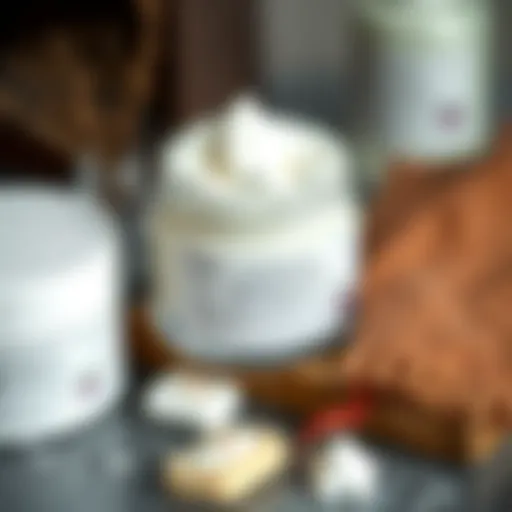Exploring the Unique Aroma of Ambra in Perfumery


Intro
Exploring the scent of ambra is like embarking on a fragrant journey through time and culture. This captivating aroma, with roots tracing back to antiquity, holds a special place in the realms of perfumery and personal care. For both enthusiasts and professionals in the beauty industry, understanding the nuances of ambra unveils not just a scent, but a rich narrative woven into the very fabric of olfactory art.
Ambra, often associated with warmth and depth, is more than just a pleasant fragrance. The history behind its use in perfumes and cosmetics reveals connections to trade routes, cultural practices, and evolving tastes. As we dive into this exploration, we’ll dissect ambra’s riveting characteristics, its source, and how it continues to play a significant role in modern fragrance compositions.
As with many perfumes, ambra evokes various emotions and memories, making it a complex topic ripe for discussion. Through this article, we aim to unpack the essence of ambra and its significance in today's beauty landscape. We invite you to discover how this unique aroma not only enchants the senses but also serves as a bridge between the past and the present.
Intro to Ambra
Ambra, a scent that lingers in the air like an echo of forgotten tales, holds a significant place not just in perfumery but across many cultures. Understanding this unique olfactory experience is not only about enjoying the fragrances that incorporate ambra, but also about grasping the deep-rooted connections it shares with human history, tradition, and even nature itself. This enhances our appreciation of personal care products and enriches our sensory journeys.
Definition and Overview
Ambra, often referred to as ambergris, is a substance that originates from the digestive system of sperm whales. When this waxy mass is expelled into the ocean, it undergoes a remarkable transformation through exposure to the elements over many years. This metamorphosis results in a robust, complex aroma that many describe as warm, musky, and slightly sweet. The essence of ambra has been sought after for centuries, valued not just for its scent but also for its ability to act as a fixative in perfumes, enhancing other fragrant notes.
Its diverse applications stretch from ancient practices to modern cosmetics, making it a subject of fascination. The distinctive scent plays a pivotal role in defining the olfactory palette of numerous perfumes, capturing both the complexity of nature and the elegance of craftsmanship.
Cultural Significance
From ancient civilizations to contemporary society, ambra has woven itself into the fabric of various cultures. Its discovery has birthed fascinating legends, intertwined with tales of exploration and trade across seas. In medieval Europe, for instance, ambra was valued not only for its scent but also for its purported medicinal properties.
"Ambra has traveled through time—each whiff carries whispers of journeys taken and stories told."
The societal perception of this aromatic substance has shifted dramatically. While once considered a luxury reserved for the elite, today, ambra is finding its way into products designed for the masses. It serves both practical and symbolic roles, bridging the world of nature and human craftsmanship, beauty and utility, art and commerce.
Thus, understanding ambra is not merely a sensory exercise; it is a broader exploration of its historical, cultural, and emotional resonance. By grasping these layers, one can truly appreciate its essence—an aroma steeped in time and significance.
Chemical Composition of Ambra
The chemical composition of ambra plays a significant role in understanding its unique aromatic profile. By examining its constituents, one can appreciate how ambra evolves in terms of fragrance and utility. Ambra, being a complex substance, is not merely one note but rather a symphony of various aromatic compounds that bring richness to perfumery and other applications.
Natural Sources
Ambra, traditionally, is derived from the ambergris, a waxy substance produced in the intestines of sperm whales. The process of formation is intricate. When undigested remains of squid or other prey accumulate in the whale's stomach, they can irritate the digestive system. As a response, the whale secretes a substance to coat the irritants, which eventually solidifies and is excreted. This ambergris then drifts in ocean currents for years, maturing its scent—much like a fine wine.
- Sea Conditions: The aroma is influenced by environmental factors, as prolonged exposure to saltwater and sunlight transforms its initial scent to that richer, more desirable material.
- Age Matters: Older specimens yield a more intricate scent profile, filled with alluring scents reminiscent of sweet tobacco, musk, and even floral hints.
- Rarity: Due to its origin, natural ambergris is rare, making it highly valuable in perfumery.
This natural source, however, comes with ethical considerations regarding its sourcing and sustainability, as the sperm whale population is endangered. As such, natural ambergris's role is often overshadowed by alternatives that do not compromise marine life.
Synthetic Alternatives
The demand for ambra has led to the development of synthetic compounds that mimic its aroma. These alternatives provide a more accessible and ethical option for fragrance creation, without the environmental impact of sourcing natural ambergris. Key points regarding synthetic variants include:
- Performance: Synthetic ambra typically offers a consistent fragrance that can be fine-tuned, appealing to perfumers looking for reproducibility in their creations.
- Eco-Friendly Options: These synthesized scents often have a smaller carbon footprint and do not contribute to the depletion of marine resources.
- Fragrance Families: Synthetic ambra blends easily with other fragrance families, enhancing notes of wood, spice, and even floral scents, giving perfumers flexibility in their artistry.
Synthetic ambra highlights how modern perfumery adapts to change without losing its creative edge.
The Olfactory Profile of Ambra
Understanding the olfactory profile of ambra is essential in grasping its significance in perfumery and cosmetic applications. The scent of ambra is not just a singular note but a complex amalgamation of various elements that contribute to its unique allure. It serves as a cornerstone in many fragrances, providing depth and richness. In this section, we will explore the key notes found in ambra and provide a comparative analysis with other scents, enhancing our appreciation of this aromatic substance.
Key Notes in Ambra
The fragrance of ambra manifests itself through a blend of distinctive key notes. Ambra is primarily known for its warm, resinous character. Below are some of the notable notes that create its olfactory signature:
- Resinous Sweetness: The sweetness often resembles honey or caramel, giving ambra a comforting quality.
- Woody Depth: There are undertones reminiscent of cedar and sandalwood, adding an earthy aspect that grounds the scent.
- Spicy Nuances: Some interpretations include soft spicy notes, which can invoke a sense of warmth and complexity.
- Balsamic Richness: This adds a creamy and smooth finish to ambra, creating a soothing and enveloping presence.
This intricate combination not only makes ambra captivating but also versatile. It easily blends with other fragrance notes, enhancing both floral compositions and heavier orientals. One can sense the layers as they experience ambra, each revealing itself more distinctly over time.


Comparative Analysis with Other Scents
When compared to other scents, ambra holds a distinctive place due to its unique properties. Here’s how it stacks up against some familiar aromatic characters:
- Sandalwood: While both have warm, woody notes, sandalwood leans more towards creaminess and subtlety. In contrast, ambra delivers a more robust and resinous experience.
- Musk: Similar to musk, ambra has a sensual quality that can enhance intimacy in fragrances, yet ambra offers a richer, more complex depth.
- Vanilla: While vanilla provides sweetness and comfort, ambra adds a more layered texture, with hints of spice and wood that vanilla alone doesn’t achieve.
- Patchouli: This often earthy scent contributes to a grounding effect, yet ambra, enriched with its resinous and sweet qualities, evokes warmth and transcendence, rather than earthiness alone.
Ambra's olfactory profile demonstrates that it’s not merely a base note but a fundamental element that accentuates and elevates other fragrances, creating a harmonious balance that captivates wearers.
This exploration of the olfactory profile of ambra not only illustrates its multifaceted nature but also highlights its adaptability in the world of fragrances. Its rich tapestry of notes allows it to shine in both modern perfumery and traditional compositions alike.
Historical Usage of Ambra in Perfumery
The history of ambra in perfumery is rich and multifaceted. Recognized not just as a scent, but as a cultural artifact, ambra's significance stretches back to ancient civilizations. This section explores the weight and value of ambra through the ages, offering insight into how its use has defined and been defined by evolving trends in fragrance.
Ancient Traditions
In antiquity, ambra was not merely a fragrance; it served as a vital element in rituals across various cultures. Ancient Egyptians, for example, used ambra to embalm the dead, believing that its scent would accompany the spirit into the afterlife. This practice highlighted its perceived sacredness and transformative qualities. Similarly, the Romans and Greeks cherished ambra in their basilicas and temples, signifying purity and divine connection.
The trade routes of the ancient world splashed the aromatic secrets of ambra across continents. It traveled from the East to the West, often found intertwined with other rare ingredients in some of the world’s most luxurious perfumes. Those in power such as royalty and elite would indulge in fragrances containing ambra—an emblem of wealth and status. The phrase "to be tied to ambra" was even used to connote someone of high regard, suggesting that ambra was more than just an ingredient; it was a mark of excellence.
"In the annals of perfume history, ambra stands tall as a beacon of ancient wisdom, trade, and artistry."
Evolution Through the Ages
As the centuries unfolded, so too did the usage of ambra in perfumery. The Middle Ages saw a shift; as European culture transitioned, ambra began to be woven into the fabric of both everyday life and spiritual activities. Perfume became a staple in aristocratic courts, where elegance and sensory delights were paramount. Ambra was often paired with florals like rose or jasmine, forming complex notes that graced the nobility and inspired poets and playwrights of the age.
Throughout the Renaissance, ambra maintained its mystique, often seen as a luxurious luxury. Scientists began to study its properties; they wanted to capture its essence. The development of modern perfumery in the 19th century opened new doors, creating synthetic alternatives that could mimic ambra.
Today, the legacy of ambra continues as it shapes contemporary fragrance formulations. It embodies a historical richness that modern perfumers draw inspiration from, adjusting for personal preferences and market trends. The character it brings to modern scents—the warm, sweet, and complex nuances—remains a testament to its timeless appeal. As consumers seek authenticity and nostalgia in their choices, ambra’s historical significance becomes paramount in understanding its role in today's marketplace.
The continued interest in ambra illustrates how traditions and innovations can coexist in the world of fragrance, creating a bridge from the past to the future.
Ambra in Contemporary Fragrance Creations
Ambra plays a significant role in present-day perfumery, influencing not only how scents are crafted but also how they are perceived by consumers. This section delves into the relevance of ambra in modern fragrance projects, highlighting elements like its unique properties, market appeal, and considerations that shape its usage in fragrances today.
Popular Fragrances Featuring Ambra
Ambra can be found in a variety of widely celebrated perfumes, lending them depth and complexity. Notable examples include:
- Tom Ford Amber Absolute: This fragrance showcases ambra in a unique light, blending resinous notes with sophisticated spices.
- Creed Royal Oud: In this creation, ambra helps tie together the rich woodiness and a hint of sweetness, producing an enchanting effect.
- Yves Saint Laurent Opium: Here, it contributes to the richness and warmth, making the scent irresistible while providing a sensation of luxury.
These fragrances highlight the allure of ambra, ensuring its ongoing popularity in the fragrance industry. The distinctive warmth and sensuality that ambra provides can evoke an emotional response, making it a sought-after element across diverse demographic groups, including both men and women.
Trends in Fragrance Formulation
Regarding trends, perfumers have increasingly turned towards natural ingredients. Ambra's long-standing relationship with luxurious scents keeps it relevant. Some of the notable trends include:
- Sustainable Sourcing: With the eco-conscious consumer base growing, brands are making it a priority to source ambra sustainably while ensuring its availability in the long-term.
- Layering with Other Ingredients: Nowadays, ambra is often layered with notes like bergamot, jasmine, or sandalwood to create multi-faceted olfactory experiences that appeal to modern taste.
- Unisex Fragrances: The traditional boundaries between masculine and feminine scents are blurring, and ambra fits perfectly in this movement by providing a neutral yet captivating base for a wide range of fragrances.
The ability of ambra to blend seamlessly with various fragrance types speaks to its versatility, making it an essential component of the perfumer's palette.
These trends illustrate how ambra's characteristics not just enhance contemporary scents, but also align with evolving consumer preferences. As the fragrance industry continues to innovate, the importance of ambra in cocktailing new creations remains undeniable.
Ambra and Its Role in Cosmetology
Ambra, often referenced for its captivating aroma, holds significant sway not only in the fragrance industry but also in the realm of cosmetology. Its nuanced scent profile and potential benefits have drawn attention from both skincare enthusiasts and professionals alike. Among its many roles, ambra is noted for its use in skincare products, enhancing treatments and formulations in ways that are both meaningful and effective. When discussed in the context of cosmetic applications, ambra's place becomes clear, revealing layers of benefits and considerations that warrant a closer look.
Influence on Skincare Products


In skincare, the integration of ambra often adds more than just a pleasant scent. Many brands see the advantage of utilizing ambra’s qualities to formulate products that resonate with the consumer both emotionally and physically. Here are a few ways ambra impacts skincare:
- Natural Aroma: The warm, musky scent of ambra has an alluring quality that can elevate the overall sensory experience of using a product. It transforms mundane routines into indulging rituals.
- Active Ingredient: Some formulations harness the therapeutic aspects of ambra, believed to possess calming and balancing properties. It may help in soothing the skin while adding depth to the product's profile.
- Anti-inflammatory Effect: There are some claims that ambra may contribute to reducing skin irritation. Although scientific backing is still emerging, the anecdotal evidence from traditional uses is hard to overlook.
- Preservation: The unique composition of ambra might play a role in extending the shelf life of cosmetic products, allowing them to remain effective and potent over time.
The influence of ambra on skincare products is indicative of how deeply interconnected aesthetics and functionality are in the cosmetic world today.
Potential Benefits and Uses
Ambra doesn’t merely sit pretty as a scent; its applications stretch far beyond a mere fragrance. Here are some potential benefits and uses of ambra in cosmetic formulations:
- Stress Relief: The scent of ambra is often linked to relaxation and tranquility. This makes it a popular choice in aromatherapy-infused products, where emotional well-being is a priority.
- Hydration and Nourishment: Brands are exploring how ambra can work hand-in-hand with oils and moisturizers, potentially enhancing hydration through its interplay with other ingredients.
- Antioxidant Properties: Preliminary studies suggest ambra may hold antioxidant benefits, helping to combat oxidative stress on the skin—especially appealing in products aimed at mature audiences.
- Cultural Resonance: Beyond its physical benefits, products featuring ambra might resonate with consumers searching for cultural connections or traditions, offering a sense of heritage in a contemporary form.
"Integrating ambra into skincare not only enhances the product's narrative but also aligns with the evolving consumer awareness of ingredients and their origins."
As interest continues to build in natural and potent cosmetic alternatives, ambra stands poised to create a niche for itself within this bustling market. Overall, understanding ambra's role in cosmetology sheds light on the broader trend of merging beauty with tradition, appealing to the sophisticated, conscious consumer.
Ambra in Natural Remedies
Ambra has long been perceived as more than just a delightful scent; it has carved a niche in the realm of natural remedies. The essence of ambra, widely appreciated for its unique aromatic qualities, also holds considerable importance due to its purported therapeutic benefits. As modern society tends to return to nature for solutions, the growing interest in ambra as an ingredient in holistic practices cannot be overstated. Let’s delve into its therapeutic properties and traditional uses, which highlight its multifaceted role in natural health.
Therapeutic Properties
The therapeutic properties of ambra are often discussed among herbalists and natural health enthusiasts. While many think of ambra purely in terms of its scent, its potential to positively influence emotional and physical well-being is something to consider.
- Calming Effects: Many users report that ambra has a soothing aroma which can alleviate stress and anxiety. This calming influence can create a serene atmosphere, promoting emotional balance.
- Antimicrobial Qualities: Some studies indicate that ambra may possess antimicrobial properties, making it a favorable choice in ointments and salves aimed at promoting skin health.
- Aphrodisiac Attributes: Historically, ambra has been considered an aphrodisiac. Its warm and earthy scent might stir the senses, potentially enhancing mood and intimate experiences.
As such, integrating ambra into aromatherapy practices not only elevates the olfactory experience but may also complement emotional and mental well-being.
Traditional Uses
As we peel back the layers of history, ambra has a rich heritage of traditional uses across different cultures. While its modern applications are catching up, these time-tested practices offer valuable insights into ambra's role in holistic wellness.
- Aromatherapy: For centuries, ambra has found its way into aromatic oils, embraced in various cultures as a medium to achieve relaxation and rejuvenation. Aromatherapists frequently incorporate it into blends intended for stress relief.
- Cultural Rituals: In some cultures, ambra has been included in rituals aiming at purification or protection. Its association with cleansing makes it a significant element in spiritual practices.
- Traditional Medicine: Some folk medicines utilized ambra as a remedy for ailments like headaches. Its scent was often used in traditional remedies, albeit with varying levels of scientific backing.
"Ambra transcends mere fragrance; across cultures, it has been a companion to spiritual practices and wellness rituals."
Market Trends for Ambra-Inspired Products
As the world of fragrance continues its evolution, ambra has carved a niche of significance within the market. Understanding the market trends for ambra-inspired products is not just about identifying what smells good. It's about diving into the overarching consumer behavior and preferences that drive the industry's direction. This discussion touches on multiple avenues, such as sustainability, cultural relevance, and shifting demographics, all shaping the way ambra is perceived and marketed.
Consumer Preferences
When it comes to fragrance choices, consumers are not just looking for something that smells nice; they want a connection. Ambra appeals to a wide demographic for its rich, warm notes that evoke feelings of comfort and luxury. This scent often conjures images of sun-drenched shores or the lush earth after a rain—sensations deeply rooted in memory and place.
Recent surveys indicate that consumers, especially younger generations, are gravitating towards fragrances that offer depth and complexity. They want unique scents that stand out and tell a story. Ambra fits this bill perfectly, often being described as possessing elements of sweetness, saltiness, and warmth, which makes it a versatile and beloved ingredient in many modern perfumes.
Some key factors driving consumer preference in the ambra market include:
- Sustainability: A growing emphasis on ethical sourcing means shoppers are more discerning about where their fragrances come from. Brands using ambra sourced sustainably can enjoy a significant boost in consumer interest.
- Personalization: There’s a notable shift towards personalized fragrance experiences, with ambra capable of blending seamlessly with other notes to create a unique signature scent.
- Health Consciousness: As more people become aware of the ingredients in their products, there is a demand for natural and non-toxic fragrance options. Ambra, often derived from natural origins, can satisfy this consumer thirst.
Economic Impact on the Fragrance Industry
The impact of ambra on the fragrance industry is profound and multifaceted. Recent trends reveal that products featuring ambra are seeing a notable uptick in sales. This is not merely a fad; industry reports indicate that ambra-based fragrances have gained popularity in luxury segments, often commanding higher prices than their synthetic counterparts.
The economic landscape within the fragrance industry is evolving, particularly as ambra takes center stage in niche markets. The growth patterns suggest a robust future, largely due to several factors:
- Market Expansion: Ambra-inspired products are recognized in both Western and Eastern markets, broadening the consumer base remarkably.
- Luxury Appeal: The association of ambra with high-end luxury items enhances brand prestige and can justify higher price points.
- R&D Investments: Companies investing in research and development are exploring new techniques to create emergent variations of ambra scents, ensuring a fresh supply of innovative products.
"Ambra not only enhances the olfactory experience but also feeds a burgeoning demand for rich, multifaceted fragrances in a market hungry for more than just sweet smells."


The result is a vibrant battleground for fragrances. With ambra at the core, brands that understand these trends can position themselves effectively in an increasingly competitive landscape. The fragrance industry is undoubtedly influenced by these shifts in consumer preferences and economic factors, making ambra a focal point in discussions of future growth.
Conducting a Sensory Analysis of Ambra
Methodologies in Sensory Evaluation
When evaluating ambra, several methodologies come into play, creating a structured approach to sensory analysis. Here are a few key methods commonly employed:
- Descriptive Analysis: This involves a trained panel who evaluates ambra based on specific attributes—smoky, sweet, warm, or earthy. Each characteristic gets a descriptor, providing a cohesive language for discussing the scent.
- Hedonic Scaling: Participants are asked to rate their likes or dislikes about ambra on a numerical scale. This method helps to quantify personal preferences, offering insight into how ambra is perceived across different demographics.
- Triangle Testing: In this method, participants are presented with three samples, one of which is different. This helps to identify subtle variations in ambra’s scent profile or effectiveness of synthetic alternatives.
Utilizing a combination of these methods affords a layered understanding of ambra. Different techniques allow for varied perspectives, ensuring that the final interpretation of the aroma is as rich and full-bodied as the scent itself.
Interpreting Results
Interpreting the findings of sensory analysis is no simple feat; it requires a careful consideration of both quantitative data and qualitative insights. The following are key aspects to focus on:
- Trends in Preference: By examining hedonic scales, one can determine what aspects of ambra resonate with consumers. If a higher proportion of participants rate notes as sweet or woody favorably, this suggests that these characteristics should be emphasized in fragrance formulations.
- Correlation with Demographics: Evaluating sensory data by age, gender, or cultural background can unveil fascinating insights. For instance, younger consumers may lean towards lighter, fresher interpretations of ambra, while more mature audiences might favor deeper, more complex blends.
- Quality and Authenticity: After analyzing the distinct characteristics of ambra, one can ascertain whether certain products maintain a level of authenticity. This is particularly pertinent given the rise of synthetic ambra alternatives, which may capture certain notes but alter the intended depth and complexity of the scent.
"A true understanding of ambra is not just about recognizing individual notes; it is about feeling the story that unfolds as you experience it."
Ambra's Environmental and Ethical Considerations
The exploration of ambra extends beyond its captivating aroma and cultural significance; it also invites scrutiny of the environmental and ethical concerns surrounding its production and use. As our understanding of sustainability deepens, questions arise about the impact of ambra sourcing on ecosystems and whether its pursuit aligns with ethical practices in the fragrance industry. The balance between luxury and responsibility is crucial in today's world.
Sustainability Issues
Sustainability is no longer just a buzzword; it’s a necessity, especially in industries that rely on natural resources like perfumery. When discussing ambra, one must consider the ecological footprint of its extraction. Natural ambra, derived from the digestive secretions of sperm whales, poses significant sustainability challenges. The hunting of these magnificent creatures, once commonplace, has been outlawed in many countries. However, issues remain regarding the byproducts of such practices and the need for sustainable sourcing alternatives.
- Habitat Protection: The extraction processes for natural ingredients can disrupt local ecosystems and endanger wildlife.
- Overexploitation Risks: The demand for ambra can lead to overharvesting, risking population declines and endangering species associated with its source, such as the sperm whale.
In contemporary fragrance crafting, there’s a growing trend towards the use of synthesized ambra notes. This synthetic approach not only alleviates the pressure on natural resources but also ensures a consistent product free from the ethical quandaries of animal-derived materials. Thus, supporting synthetic alternatives contributes to a more sustainable and ecologically sound fragrance industry.
Regulatory Standards and Practices
Regulatory standards play a pivotal role in ensuring the ethical production of ambra and its derivatives. Countries have established guidelines addressing not just the safety of fragrance ingredients, but also their environmental impact. This framework provides assurance that products in the market meet health and safety standards while minimizing adverse effects on the planet.
"With appropriate regulations, the industry can facilitate ethical sourcing practices while satisfying consumer demand for ingredients like ambra."
- International Regulations: Various international agreements, alongside local laws, govern the harvesting and trade of animal-derived products, ensuring protection for endangered species.
- Certifications: Look for sustainability certifications when sourcing fragrances containing ambra. These tags signify adherence to ethical standards, helping consumers make informed choices.
Culmination
In bringing our exploration of ambra to a close, it merits discussion about its fundamental importance within the realms of fragrance and cosmetic industries. Ambra serves not merely as a perfume note, but as a rich historical symbol reflecting diverse cultural practices and aesthetic forms. Its unique scent profile—characterized by warm, musky, and slightly sweet notes—not only enchants the senses but also invokes nostalgia, tying back to ancient traditions.
Moreover, in a world increasingly defined by ethical dilemmas, the exploration of ambra also highlights underlying issues of sustainability and ecological responsibility. As the industry leans heavier on synthetic alternatives and sustainable sourcing, understanding ambra's role can inform and inspire better practices among creators and consumers alike.
The key aspects of ambra discussed throughout this article bear significant relevance:
- Cultural and historical narratives connect us to past practices in perfumery.
- Chemical complexity highlights the artistry involved in fragrance construction.
- Contemporary applications demonstrate ambra's versatility, bridging traditional and modern uses in cosmetics.
Each layer of ambra reveals not just a scent, but an ongoing dialogue about identity, memory, and ethical responsibility. Emphasizing its importance may offer a pathway toward innovation in perfumery, where reverence for nature complements artistry in fragrance creation.
Summarizing Key Insights
The exploration into ambra has illuminated numerous critical insights:
- Ambra is historically significant and continues to capture interest in today’s perfume market.
- Its unique olfactory profile—combining sweet and animalistic notes—adds depth and richness to various fragrances.
- The shift towards natural and ethically sourced ingredients sheds light on sustainable practices that benefit both the environment and the fragrance industry.
In essence, ambra occupies a unique place in the scent hierarchy, speaking to lovers of fragrance as well as casual consumers. Understanding its intricacies allows for a refined appreciation of its role in modern perfumery.
Future of Ambra in Fragrance and Cosmetic Industries
Looking ahead, ambra’s evolution in the fragrance and cosmetics industries raises intriguing possibilities. As consumers become more discerning—valuing authenticity, sustainability, and personal expression—ambra stands poised to play a central role.
Several trends indicate potential growth areas:
- Bespoke fragrances: Tailoring scents to individual preferences may incorporate ambra’s warm notes, as they enhance personal stories and unique experiences.
- Sustainable ingredients: With a greater focus on sourcing practices, ambra's environmental impact can be minimized, making it appealing in a market keen on ethical consumption.
- Collaborative creations: The fusion of traditional and modern artisan techniques could lead to innovative ambra-centric fragrances, pushing perfumers to explore new boundaries.















